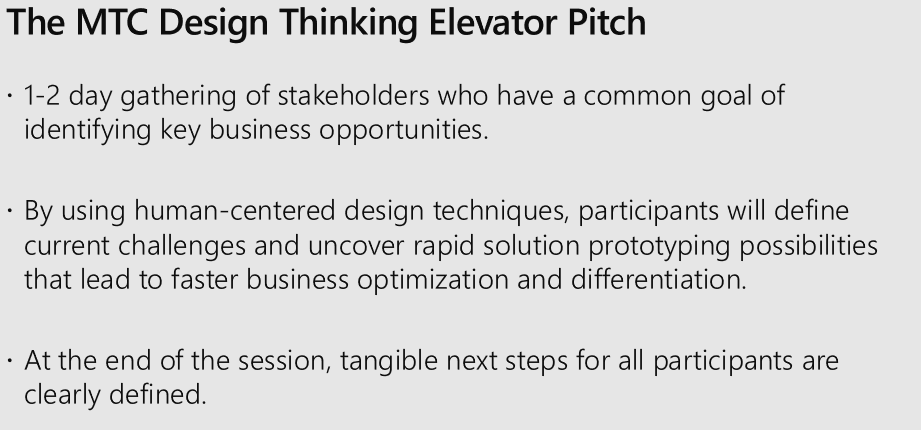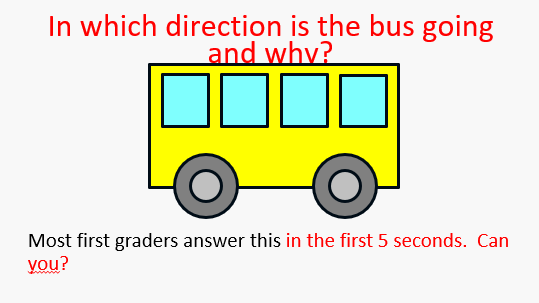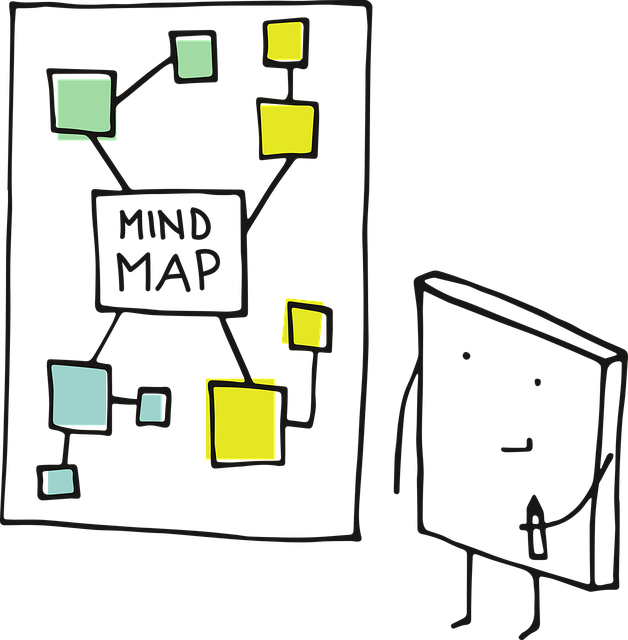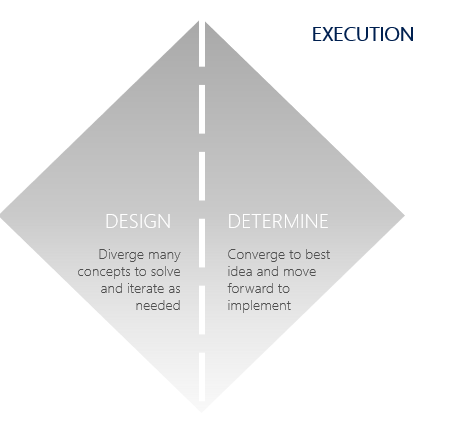Design Thinking for Data and Analytics Projects
Data science and analytics projects are risky. We should leverage anything that removes risk, delights our users, and shortens time-to-market. I am a data evangelist at the Microsoft Technology Center. We are a service that helps our customers on their Digital Transformation journeys. We have a limited amount of time to show value and deliver a compelling solution to a business problem (generally, 3 days). The primary tool we use to ensure success is Human-Centered Design Thinking (DT). Successful data projects are less about the technology and more about the process and people. Let’s walk through what DT is, when you should use it, how you can leverage it, and how you can engage with the MTC to do a Design Thinking workshop with your team. We’ve helped our customers win awards based on our DT sessions. Does that sound compelling?
What is Design Thinking
Our workshop theme: think like children.
 Design thinking is an activity that builds upon the deep understanding of your users and customers to generate ideas, build prototypes, share experiences, solve problems, and embrace “failure”. There are many reasons to do a DT workshop, I’m going to focus specifically on how DT can improve outcomes on data science and analytics projects.
Design thinking is an activity that builds upon the deep understanding of your users and customers to generate ideas, build prototypes, share experiences, solve problems, and embrace “failure”. There are many reasons to do a DT workshop, I’m going to focus specifically on how DT can improve outcomes on data science and analytics projects.
Poorly designed products serve their creators (or sponsors) first and the users second. Good design attempts to understand the intended users and build something that delights them and solves their problem and not someone else’s notion of what their problem is. Often we think we are showing empathy but we are really dismissive of it for the more concrete and measurable virtues of rational analysis. We use numbers and math to justify why we are right. Rational analysis does not inspire.
I’m a data scientist. And I’m telling you not to fall for the trap of rational analysis. Listen to your users and build solutions with empathy.
Business leaders (and sometimes even IT) have a lot of misconceptions around what problems AI and machine learning can solve. We often hear comments like:
- “We want to be an AI Company”
- “How can we inject ML into our applications and processes to generate revenue?”
- “We hope to use AI to solve a complex business problem.”
Those statements are a bit nebulous. AI isn’t magic pixie dust. It can do amazing things, if you understand what is possible. We use DT workshops to focus these broad, strategic statements into crisp questions that data science can actually answer. Then we build out a prototype that you can use to sell to your leadership.
But DT can be used almost daily in the value-stream and is proving to be quite effective as a replacement/augmentation for traditional scrum and agile methods.
DT practitioners have some core values:
- we are collaborative: we LISTEN to our customers before we propose solutions. We have Know-What, not just Know-How. We don’t accept statements like “our users want…”. Instead, we want to talk to those users directly, unfiltered. When we can do this we get the most candid feedback and we can ultimately build the best solutions for them. We need our users to collaborate with multiple teams and stakeholders: developers, data professionals, business executives, marketers, sales. During our DT workshops we have representation from each of these groups.

- technology is secondary to the human. More than anything else, we are user-centric. We put the human at the heart of what we do. We don’t use innovation for its own sake. In many of our DT workshops technology topics don’t even come up. In fact, the most common feedback we hear after our DT sessions is:
This is unlike anything we’ve ever done with Microsoft. We focused on understanding business problems before we talked about solutions. This was very refreshing. We found some solutions by simply altering our processes. We actually didn’t need to roll out my software.
- iterative, fail-fast mentality. Successful data science projects are a series of small experiments. Each experiment will have an outcome with learnings. We may need to shift direction quickly. This is continuous improvement. We like to do “mini-DT sessions” where we can focus on what to do next and what we’ve learned. Sometimes that means we haven’t found the business value we were hoping to and it’s time to scrap the project.
What does a DT workshop look like?
 Our DT workshops are usually 2 days. Some DT practitioners have multi-week design sprints. We feel most companies can’t devote that much time (especially executives). Instead, we start small. And we advocate doing additional DT sessions as needed, later.
Our DT workshops are usually 2 days. Some DT practitioners have multi-week design sprints. We feel most companies can’t devote that much time (especially executives). Instead, we start small. And we advocate doing additional DT sessions as needed, later.
Preparation
We ask that you give us a business problem you want help with. It’s best to structure the business problem as a “How might we” statement. Some examples:
- How might we use data, AI, or ML to lower our customer acquisition costs?
- How might we improve our website’s user engagement?
- How might we use AI to automate mundane tasks for our sales teams?
These are broad statements that will allow our DT workshop focus to go in many different directions based on conversations.
We ask that you invite both business and IT leadership and stakeholders, as well as your “customer” or user representatives. 15-20 attendees will allow us to have 3-4 “collaboration teams”, but we’ve conducted workshops with over 50 attendees. We did one DT workshop for a Fortune 500 company that included 20 total attendees…including 2 members of the C-Suite and 2 interns. Quite a diverse audience.
“We weren’t sure if AI was just a shiny object, or would it really work for us. We learned what really works” –actual survey feedback
Introductory Games
The first interactions are always challenging. Often participants don’t know each other. Other times there may be executives in the room so attendees fear  speaking up and participating. We break this tension by playing games and doing interactive activities. Instead of doing standard “introductions”, we play introductory games. This breaks some of the tension but it also allows me to understand the power dynamics in the room. Invariably all of the executives sit together and the IT folks sit at a table by themselves. After the introductory games I shuffle the tables/teams so each team has representation from different stakeholder groups. Then we play another game to get people to be comfortable with each other. We even sing songs…yes, you heard that right. But we aren’t goofing off, these activities serve higher purposes. We want attendees to think differently about their world. Leave your preconceived notions at the door. We want attendees to think like children and be creative. We want participants to be less rational and analytical and more open to new ideas. Exercise your right brain muscle.
speaking up and participating. We break this tension by playing games and doing interactive activities. Instead of doing standard “introductions”, we play introductory games. This breaks some of the tension but it also allows me to understand the power dynamics in the room. Invariably all of the executives sit together and the IT folks sit at a table by themselves. After the introductory games I shuffle the tables/teams so each team has representation from different stakeholder groups. Then we play another game to get people to be comfortable with each other. We even sing songs…yes, you heard that right. But we aren’t goofing off, these activities serve higher purposes. We want attendees to think differently about their world. Leave your preconceived notions at the door. We want attendees to think like children and be creative. We want participants to be less rational and analytical and more open to new ideas. Exercise your right brain muscle.

I’ve had customers tell me the games and activities are the most valuable part of my DT sessions and everyone wants to steal them.
Listen…ask anyone about me. They’ll tell you I am the least creative, most analytical, introverted person they know. These sessions are difficult for me and it’s taken years for me to trust the process. I truly believe DT works.
 A DT workshop is a “judgment-free zone”. We encourage attendees to tell us their wildest, craziest ideas. The best way to have a few good ideas is to start with a lot of ideas.
A DT workshop is a “judgment-free zone”. We encourage attendees to tell us their wildest, craziest ideas. The best way to have a few good ideas is to start with a lot of ideas.
Now the real DT magic happens in the workshop. We focus on Strategy and Execution.
Strategy: Discover and Define the Problems

We have a series of “divergence” activities to “discover” all of the different problems related to our area of focus. We want LOTS of problem ideas. We want each attendee to list as many problems as she can. We share and talk about these problems in small group activities. We rank and vote on them and we “cluster” the problems together. The clustering exercise allows us to see the trends.
Then we share our findings with the other teams. Invariably we find similar problems and clusters. We begin to talk about “personas” or groups of people that are affected by these problems. We again start to see patterns in how these problems affect humans.  This is a lot like “mind mapping” but I make it less formal and allow the process to occur naturally.
This is a lot like “mind mapping” but I make it less formal and allow the process to occur naturally.
We begin to pare down the list of problems to the ones that are the highest priority. Each team picks the problem they want to focus on. Sometimes we shuffle the teams if some attendees have strong feelings about the problem they want to work on.
The groups begin digging into the assigned problem and we have group activities to ensure everyone understands as much about the problem as possible. These “convergence” activities allow us to focus our scope and gain a deep understanding of all aspects of the problem.
Our teams report their findings back to the bigger team and we have activities to ensure everyone understands the problems.
“Initially we focused on ‘hero’ AI scenarios. During the workshop we realized there were more valuable use cases where we could experiment with AI.” –actual survey feedback
Execution: Design the Solution and Determine the Implementation

With a thorough understanding of the problems, we need to think about solutions. Most of us aren’t “right brained” so this is difficult (especially IT folks). Hands-on activities help us to think about simple solutions to complex problems. And I do mean “hands-on”…these activities are highly tactile. We again do “divergence” activities where we think about all of the possible ways we might solve our problems. We collaborate, rank, and cluster the potential solutions. Be creative!

Next, we again have “convergence” activities that help us determine what the right solution is. We all arrive at the same conclusion based on the exercises. An example of a simple exercise is a cost-impact matrix. These work great to focus on the most viable solutions. 
Once we’ve converged on a solution we begin the prototyping exercise. Prototyping does not mean writing software or developing an AI algorithm. It means drawing the solution, describing it in prose, sometimes building it with modeling clay or Legos. It needs to be visual. An AI algo is not visual, it’s nebulous (at best) and few non-data scientists will understand it. Instead, we want users to see how they will be impacted.
With a prototyped product we are proud of, we need to think about the implementation. We do activities and games that allow us to “sell” our ideas to each other. This allows you to think through how to sell (market) this product to your stakeholders. Activities range from building a business model canvas, to a “design the box” game, to writing an “elevator pitch”.
My favorite activity is what I call “corporate storytelling”. The real knowledge in any company isn’t documented, but passed down in the form of stories. Think water cooler gossip. We want our solutions to be wrapped in a good story that is inspirational.
DT Workshop Outcomes
Here’s how I know my DT workshops are fun and valuable: I have NEVER seen an attendee checking email on their laptop or doomscrolling Facebook on their phone. NEH-VER.
We want you to leave our DT workshops with a better understanding of your problems and which can actually be solved with data science. Then we want you to have some concrete solutions with initial rough prototypes that you can sell to your stakeholders with confidence. We want you to feel invigorated and excited about the Art of the Possible.
“The workshop was a low investment for a high return. We enjoyed this!” –actual survey feedback
When Should You Propose a DT Workshop?
Short answer: any time you want your business leaders and IT to collaborate on solutions.
Frankly, 1 day DT workshops are an excellent replacement for Sprint Planning and retrospective meetings. Instead of talking about upcoming work (or the work just completed), you can actually build a prototype and understand the solution. Obviously we limit the games and introductory exercises in shorter DT sessions.
If your team is questioning scope or direction after a few sprints, consider scheduling a quick DT session to advance the project. If you follow Kanban this is especially valuable since Sprint Planning is less formal. Why spend a day doing planning when you can spend a day actually looking at solutions and building a prototype?
Here’s some other times when DT is valuable:
- IT wants to build or re-establish client relationships with LoBs

- Different business units want to engage each other in a safe space
- IT has a vague notion of business priorities but aren’t sure where to focus
- You are trying to develop a strategy or new product, but don’t know where to start
Deep understanding drives empathy.
At the MTC we also do “mini DT sessions” as part of most of our multi-day MTC hackathons and hands-on events. We spend 1-4 hours where we very quickly talk about business problems and iterate on solution ideas. These are much more focused (no games and song singing) and we (unfortunately) skip many of the fun activities.
DT as a risk management and project management tool
Data analytics projects are risky. Data science is still relatively new to most organizations which just adds to the risk. DT is perfect for controlling risk. In traditional scrum/agile software projects we forge ahead for long periods of time without getting user feedback. In the worst cases our analysts talk to our users and write a requirements document that engineering then implements. This could take months. Finally we demo our product to our users and invariably they don’t feel like we understood their needs. Or, simply, the requirements have changed.
The Agile Manifesto says that we should be working collaboratively with users and customers, but we all know that doesn’t tend to happen. With DT we force this to happen by having the users materially participate in not just the design, but also in “selling” the idea and building the prototype. Users feel that IT is finally listening to them and they have skin in the game. When they can review a new prototype regularly, we can change direction based on learnings. This saves time and money and removes risk.
The MTC is here to help you!
The Microsoft Technology Center is a service that helps Microsoft customers on their Digital Transformation journey. We know that  successful software projects are less about the technology and more about the process and people.
successful software projects are less about the technology and more about the process and people.
“We didn’t know the MTC did that,” … is a common reaction we hear from our customers. Microsoft, of course, focuses heavily on our tech solutions, but we also strive to be the Trusted Advisor for our customers. We’ve actually done this DT stuff in the real world and we know the patterns and anti-patterns. A lot of the engagements we do focus on culture change, like our DT workshops. We’ve had a few customers with internal “innovation teams” come to learn from us how to host a successful DT workshop. I am always very honored to do this. We host their first DT session solely so they can watch us and learn our tricks for better engagement with business leaders.
We believe in this stuff.
Does that sound like someone you can trust?
Want to learn more about how design thinking can help your team? Contact your Microsoft account rep today.
Are you convinced your data or cloud project will be a success?
Most companies aren’t. I have lots of experience with these projects. I speak at conferences, host hackathon events, and am a prolific open source contributor. I love helping companies with Data problems. If that sounds like someone you can trust, contact me.
Thanks for reading. If you found this interesting please subscribe to my blog.
Related Posts
- What I Learned from Re-Reading The Goal
- PolarisCon Conference Speaker
- Forrester 2020 Enterprise Architecture Award Winner
- Blockchain Ideation and Hackathon at Global 2020 Summer Azure DataFest
- AI Envisioning Workshop at Philadelphia Azure DataFest
Dave Wentzel CONTENT
data science Digital Transformation data architecture management workshop design thinking

